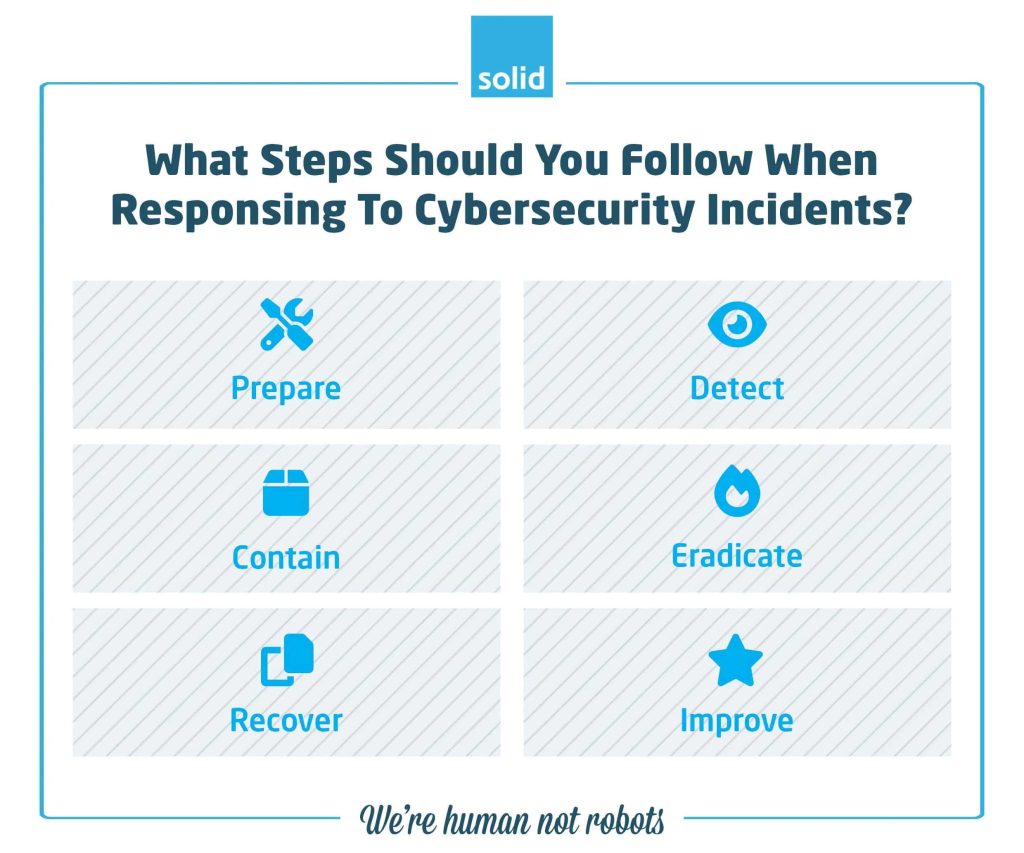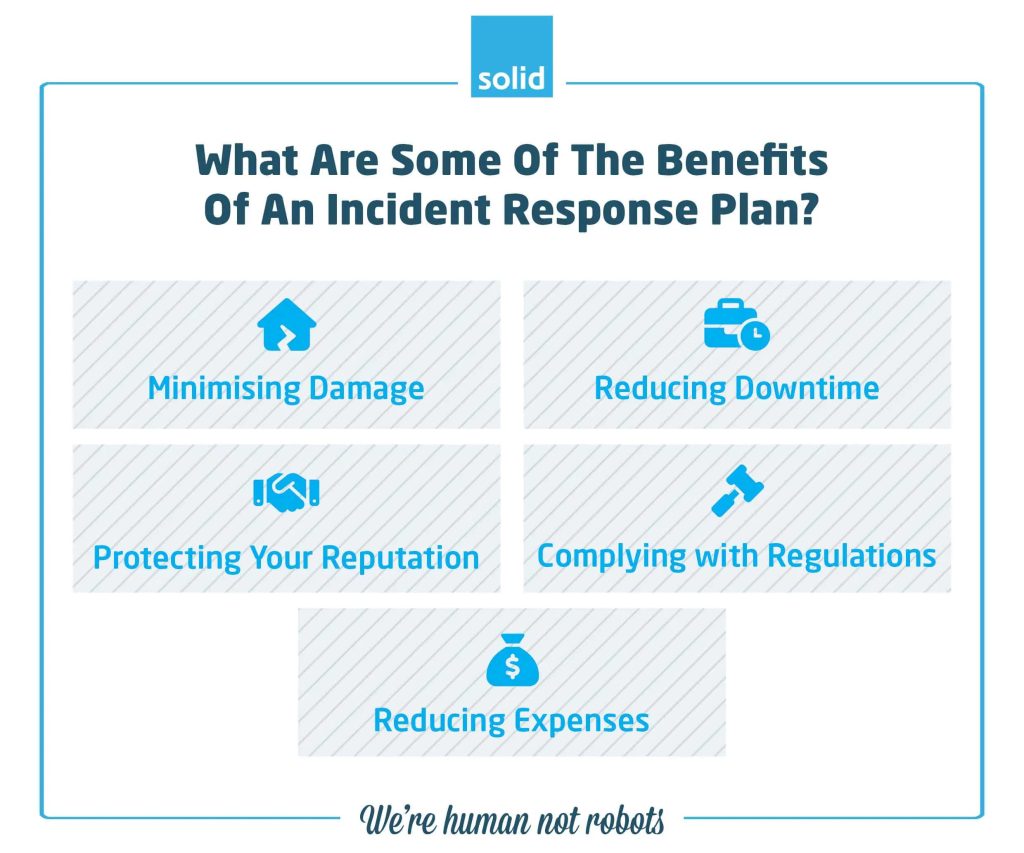
With the increasing threat of cyber attacks, it is essential that your business has a robust incident response plan in place. Cybersecurity incidents can cause severe damage not only to your reputation but also to your financial stability and data security. This makes it crucial to have an effective and efficient cybersecurity incident response strategy in place.
What Is A Cybersecurity Incident Response?
A cybersecurity incident response refers to the processes and procedures put in place to detect, handle and manage cyber attacks or data breaches. It involves identifying, containing, eradicating, and recovering from a security incident.
One example would be how a business would respond to a ransomware attack. It might start with your humans noticing that they can’t access files, followed by an emailing letting you know that your data has been compromised and held at ransom by an attacker.
Once you’re aware of the attack, the incident response team would first work to determine how widespread the attack is, and would then try to isolate the affected systems to prevent the spread of the ransomware within the network. They would then begin the process of removing the ransomware from the infected systems. This could involve restoring the systems from a clean backup or using specialised tools to remove the ransomware and recover encrypted files. In the worst-case scenario, if you didn’t have backups of the data, it could involve paying the ransom that the attacker is demanding.
After the cybersecurity incident is resolved, the team would then conduct a post-incident review to identify how the ransomware entered the network, and what steps could be taken to prevent similar attacks in the future. This review often leads to updates in policies, procedures, and security controls to strengthen your defence against future cyber attacks.
What Are The Different Types Of Cyber Security Incidents?
Cybersecurity incidents can take various forms, with each type requiring a different approach to response and mitigation.
• Unauthorised Attempts To Access Systems Or Data
This type of incident involves an unauthorised user trying to gain access to your systems or data. It could be through brute force attacks or exploiting vulnerabilities in your network.
• Privilege Escalation
A privilege escalation attack is when a user or an attacker gains higher levels of access to a system or network than they were initially granted. While this isn’t always intentional and can just be one of your humans accidentally accessing a file that they shouldn’t be able to, these attacks are often used by hackers who have gained access to login credentials to boost their administrative privileges and control over a network.
• Insider Threats
Insider threats refer to incidents caused by an employee or contractor within a business. These could be intentional or unintentional – it could be a disgruntled employee, or simply someone who makes a mistake and doesn’t know any better. Whether intentional or not, insider threats can cause significant damage if not detected and addressed promptly.
• Phishing Attacks
Phishing attacks are a common form of cyber attack where hackers use social engineering techniques to trick individuals into giving away sensitive information. While most people think of phishing mails as coming from strangers, they can include mailbox spoofing, where an attacker creates a fake email address in a real person’s name, making you think that the emails are coming from someone you know, when in fact they aren’t. But they can also include mailboxes becoming compromised, where the mails are coming from an official address that you recognise, but are being written by an attacker. These attacks can lead to financial losses, data breaches, and network compromises.
• Malware Attacks
Malware attacks involve malicious software designed to disrupt or damage a computer system. This can include viruses, worms, trojans, and ransomware. Such attacks can cause significant damage to your business, including data loss, financial losses, and reputational damage.
• Denial of Service Attacks
Denial of Service (DoS) attacks aim to make a system or network unavailable by overwhelming it with traffic or requests. These attacks can cause significant disruptions to your operations and result in financial losses.
• Advanced Persistent Threats
Advanced Persistent Threats (APT) are sophisticated cyber attacks that target specific businesses or individuals with the intent to steal sensitive information or disrupt operations. These attacks are often carried out by well-funded and skilled hackers, making them difficult to detect and prevent.
What Steps Should You Follow When Responding to Cybersecurity Incidents?

The primary goal of incident response in cyber security is to minimise the damage caused by a cyber attack and prevent it from happening again. The cybersecurity incident response process typically involves the following steps:
1. Prepare
Creating an incident management plan, identifying potential threats, putting IT security and backup solutions in place, and training employees on security best practices.
2. Detect
There are various tools and techniques that you can use to detect and identify any suspicious activities or cyber attacks, including setting up alerts with the help of Defender for Microsoft.
3. Contain
Once an incident is detected, it is crucial to contain it to prevent further damage. This involves identifying which systems and networks are affected, isolating them, and limiting access to them.
4. Eradicate
The next step is to eradicate the source of the attack by removing any malware or malicious code from affected systems.
5. Recover
After the threat has been neutralised, you can work towards restoring systems and data. The faster you can manage this, the less your operations and your reputation will be impacted.
6. Improve
It is essential to conduct a post-incident review to identify any weaknesses in the cybersecurity incident response process and make improvements for future incidents.
What Are Some Of The Benefits Of An Incident Management Plan?

Focusing on incident management in cyber security and putting a response plan in place can be a great benefit to your business in the face of a cyber attack. Some of the key benefits include:
• Minimising Damage
With a plan in place, you can respond quickly and effectively to cyber attacks, minimising the potential damage.
• Reducing Downtime
By having a systematic approach to cybersecurity incident response, you can reduce downtime and resume normal operations faster.
• Protecting Your Reputation
A well-handled cyber attack can help protect your reputation and maintain customer trust.
• Complying With Regulations
If your business is based in South Africa, the UK or the EU, or if you do business with companies based in those areas, the way that you manage cybersecurity incident response is especially important, since you have to make sure that your data is being collected, processed and stored in accordance with regulations like the POPI Act and GDPR. Having a cyber security incident response plan in place can help ensure that you remain compliant with these and other regulations, and that you won’t have to pay additional penalties.
• Reducing Expenses
By being proactive in your incident response, you can potentially save money on recovery costs, avoid having to pay off attackers to retrieve your data, reduce the risk of fines, avoid clients leaving because they don’t have faith that their services are secure with you, and more.
Who Is Responsible For Incident Response?
Incident response should be a joint effort between various departments in an organisation, including your IT department, your security team, your legal team, your sales, marketing and communications teams and management. But the risk and responsibility doesn’t have to fall on you alone.
The right Managed IT Services Provider (MSP) or cybersecurity partner can be a critical asset in managing and executing incident responses. As a technology partner Solid Systems not only helps you to create cybersecurity incident response and disaster recovery plans, ensuring that your business is well prepared for even the worst-case scenario, but we also support your in-house IT team in identifying and responding to cyber threats quickly and efficiently. Our additional resources and specialised knowledge in advanced threat detection and incident response can mean the difference between an attack being stopped in its tracks, or wreaking havoc for your business.
On top of this, we can help to design and implement robust security systems and IT solutions, and proactively update and monitor them for any potential breaches. And our IT Pros are always willing to share their experience, offering businesses the opportunity to train their teams in the latest cybersecurity best practices and ensuring that they understand their roles in protecting your business against attack.
Overall, working with a reliable and human technology partner like Solid Systems can significantly enhance your resilience against cyber threats, allow for faster response times, and minimise potential damage from any cybersecurity incidents.
How Can Solid Systems Help?
In today’s digital landscape, it is not a question of if, but when a cyber attack will occur. By having a well-defined cybersecurity incident management plan and involving all departments in the incident response process, you can be better prepared to handle and recover from a cyber attack. It can save you time, money and reputational damage. By actively preparing for potential incidents and working with a technology partners like Solid Systems, your business can better protect your humans, your operations, and your assets from cyber threats.
If you are looking for cybersecurity experts for IT consulting, or want to learn more about how Solid Systems helps businesses to protect themselves in this digital age and prioritise cybersecurity, schedule your free consult today.
Frequently Asked Questions
A Cybersecurity Action Plan, also known as a Cybersecurity Incident Response Plan, is a comprehensive strategy designed to guide you when managing cyber threats and incidents. It provides a structured approach to identifying, responding to, and recovering from cyberattacks, ensuring minimal disruption and loss.
Writing a cybersecurity incident response plan involves a comprehensive approach that ensures all potential threats are addressed. It involves identifying and prioritising assets, assessing the risks to your business, developing response procedures, assigning roles and responsibilities, putting a strategy in place for communicating with your teams and your clients, and constant testing and reviewing to ensure that your incident response plan is as effective as possible.
The first step of cybersecurity incident response usually involves recognising that there is a potential security incident or breach. There are a wide range of tools that can help you with this, including Defender for Microsoft, which can alert you to unusual activity within your Microsoft environment or cloud services. Once you receive an alert, it will need to be thoroughly investigated to determine whether it involves human error, or if your company is under attack. From there, it’s about identifying which systems and networks have been impacted, containing it, and working to eradicate the threat and recover from the attack.





